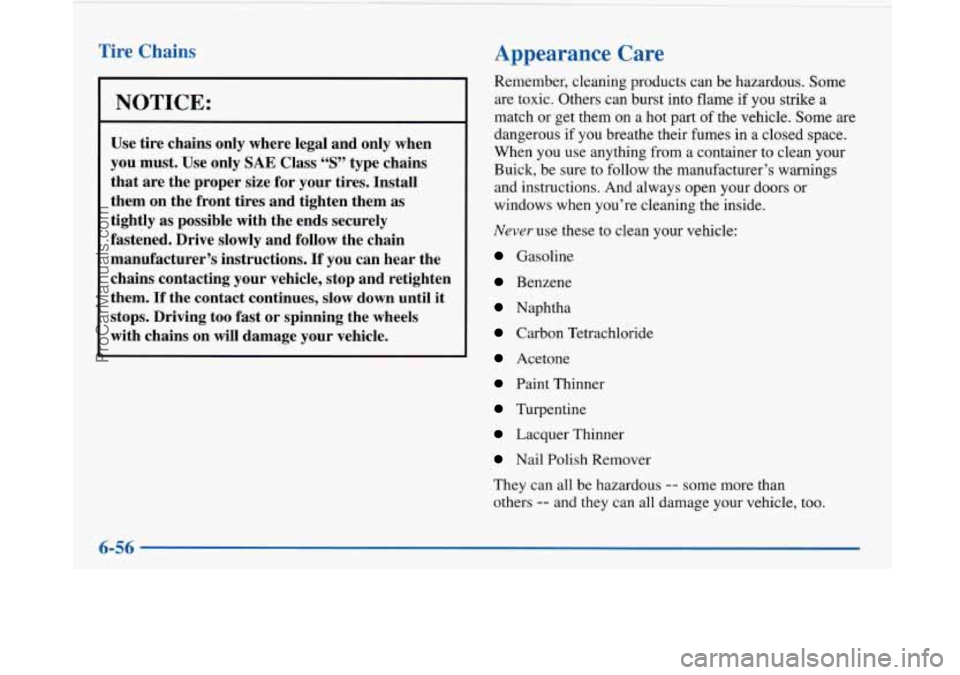Page 316 of 420

0 The tire has a puncture, cut or other damage that
can’t be repaired well because of the size or location
of the damage.
Buying New Tires
To find out what kind and size of tires you need, look at
the Tire-Loading Information label.
The tires installed on your vehicle when it was new had
a Tire Performance Criteria Specification (TPC Spec)
number on each tire’s sidewall. When you get new tires,
get ones with that same TPC Spec number. That way
your vehicle will continue to have tires that are designed
to give proper endurance, handling, speed rating,
traction, ride and other things during normal service on
your vehicle. If your tires have an all-season tread
design, the TPC number will be followed by an
“MS”
(for mud and snow). If you
ever replace your tires with those not having
a
TPC Spec number, make sure they are the same size,
load range, speed rating and construction type (bias,
bias-belted or radial) as your original tires.
-
/i CAU; ;ON:
Mixing tires could cause you to lose control while
driving.
If you mix tires of different sizes or types
(radial and bias-belted tires), the vehicle may not
handle properly, and
you could have a crash.
Using tires of different sizes may also cause
damage to your vehicle. Be sure to use the same
size and type tires on all wheels.
It’s all right to drive with your compact spare,
though. It was developed for use on your vehicle.
6-52
ProCarManuals.com
Page 320 of 420

Tire Chains
I NOTICE:
Use tire chains only where legal and only when
you must. Use only
SAE Class “S” type chains
that are the proper size for your tires. Install
them on the front tires and tighten them as
tightly as possible with the ends securely
fastened. Drive slowly and follow the chain
manufacturer’s instructions.
If you can hear the
chains contacting your vehicle, stop and retighten
them.
If the contact continues, slow down until it
stops. Driving too fast or spinning the wheels
with chains on will damage your vehicle.
Appearance Care
Remember, cleaning products can be hazardous. Some
are toxic. Others can burst into flame if you strike a
match or get them on a hot part of the vehicle. Some are
dangerous if you breathe their fumes in a closed space.
When you use anything from a container to clean your
Buick, be sure to follow the manufacturer’s warnings
and instructions. And always open your doors or
windows when you’re cleaning the inside.
Never use these to clean your vehicle:
Gasoline
Benzene
Naphtha
Carbon Tetrachloride
Acetone
Paint Thinner
Turpentine
Lacquer Thinner
Nail Polish Remover
They can all be hazardous
-- some more than
others
-- and they can all damage your vehicle, too.
6-56
ProCarManuals.com
Page 329 of 420

Appearance Care Materials Chart
PART NUMBER SIZE DESCRIPTION USAGE
994954 23 in. x 25 in. Polishing Cloth - Wax Treated
Exterior Polish
1050004 2.75
sq. ft. Chamois Shines vehicle without scratching
1050 172 16
oz. (0.473 L)
Tar and Road Oil Remover Also removes old waxes and polishes
1050173 16
02. (0.473 L) Chrome Cleaner and Polish
Removes rust and corrosion
1050 174 16
oz. (0.473 L) White Sidewall Tire Cleaner
Removes soil and black marks
1050200 1 gal. (3.785
L) Magic Mirror Cleaner Polish
'Exterior cleaner and polish
-
1050214 32 oz. (0.946 L) Vinyl Cleaner
Spot and stain removal
1050427 23
oz. (0.680 L) Glass Cleaner Cleans grease, grime and smoke film
1052870 16
02. (0.473 L) Wash and Wax Concentrate
Exterior wash
1052918"" 8
oz. (0.237 L) Armor All Rvl Protector Protects vinyl, leather and rubber
1052925 16
02. (0.473 L) Multi-Purpose Powdered Cleaner
Cleans vinyl, cloth, tires and mats
1052929 16
oz. (0.473 L) Wheel Cleaner
Spray on wheel cleaner
I 1052930 I 8 oz. (0.237 L) I Capture Dry Spot Remover I Attracts and absorbs soils
12345002"" 16
02. (0.473 L) Armor All Cleaner Cleans vinyl, leather and rubber
12345725 12
oz. (0.354 L) Silicone Tire Shine Shines tires
12377964 16
oz. (0.473 L) Cleaning Wax Protects finish and removes fine scratches
12377966
I 16 oz. (0.473 L) I I Spot cleans paint and gives high luster
Finish Enhancer
See your General Motors
Parts Department for these products. **Not recommended for use on instrument panel vinyl.
See "Fluids and Lubricants" in the Index.
6-65
ProCarManuals.com
Page 340 of 420

Capacities and Specifications
The following approximate capacities are given in English and metric conversions. Please refer to “Recommended
Fluids and Lubricants” in the Index for more information.
Belt Tensions
Automatically controlled by a Self-Tension idler pulley. Tension adjustment should never be necessary.
Automatic Transaxle AT (Overdrive)
When draining or replacing torque converter, more fluid may be needed.
Pan Removal and Replacement
................................................... 6 quarts (5.6 L)
After Complete Overhaul
...................................................... 11 quarts (10.4 L)
Cooling System ............................................................. 13 quarts (12.3 L)
Oil change with filter change ................................................... 5.0 quarts (4.7 L)
Park Avenue Ultra
............................................................ 19 gallons (72 L)
Engine Crankcase
FuelTank
......................,...........................................18gall\
ons (68L)
Power Steering
PumpOnly .....................................................................lpi\
nt (0.5L)
Tire Pressures, Sizes
The Tire-Loading Information label, which is located on the rear edge of the driver’s door, shows the correct
inflation pressures for your tires.
WheelNutTorque ........................................................ lOOlb-ft(140N~m)
Complete System
............................................................ 1
1/2 pints (0.7 L)
Refrigerant (R-l34a), Air Conditioning ................... See refrigerant charge label under the hood.
NOTE: All capacities are approximate. When adding, be sure to \
fill to the appropriate level, as recommended
in this manual.
ProCarManuals.com